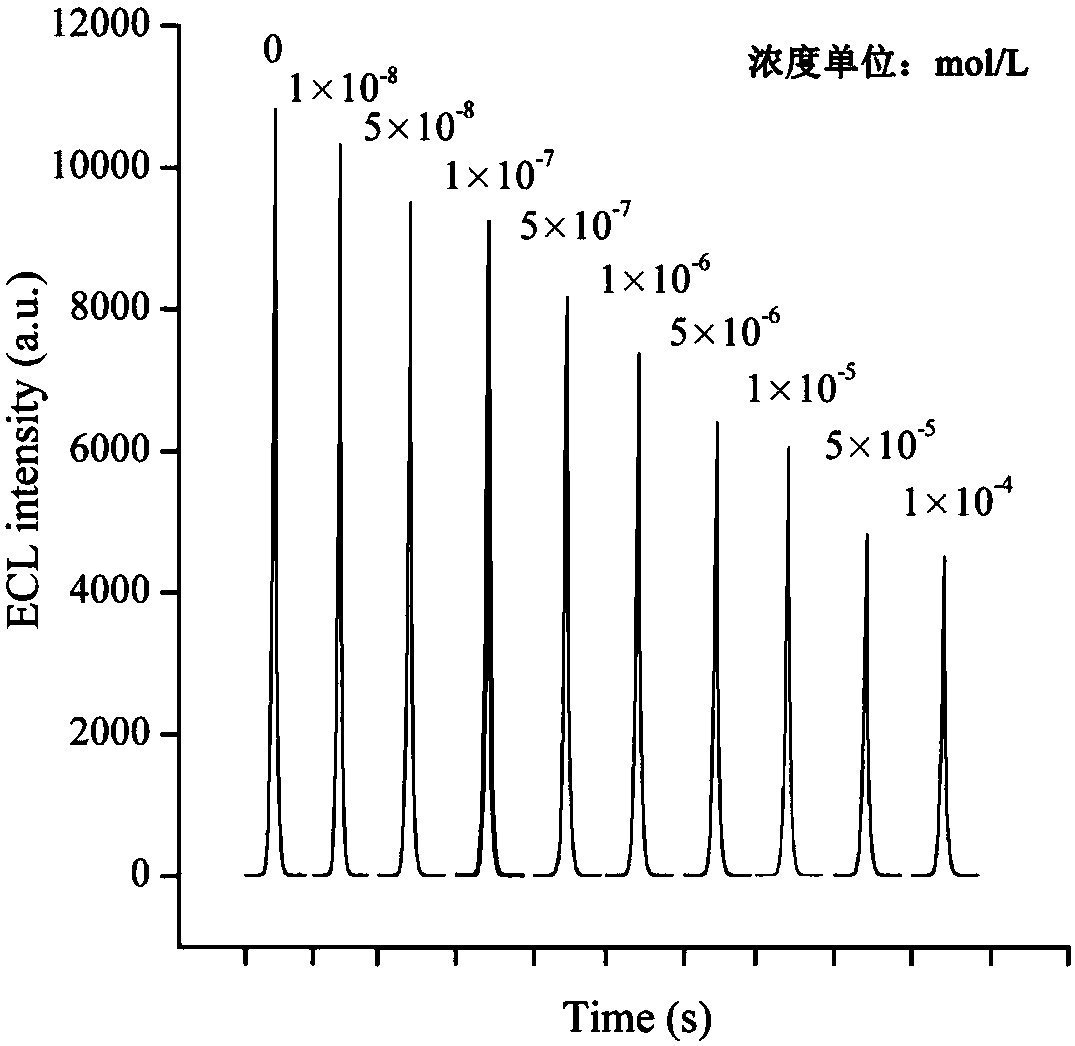Method for preparing clenbuterol hydrochloride molecularly imprinted membrane electrochemical light emitting sensor
A technology of clenbuterol hydrochloride and molecularly imprinted membranes, which is applied in the fields of chemiluminescence/bioluminescence, electrochemical variables of materials, and analysis through chemical reactions of materials, etc., to achieve a wide linear range, high sensitivity, and long service life. Effect
- Summary
- Abstract
- Description
- Claims
- Application Information
AI Technical Summary
Problems solved by technology
Method used
Image
Examples
Embodiment 1
[0045] (1) Electrode pretreatment
[0046] Before preparation, the surface of the glassy carbon electrode was polished with 1.0, 0.3, and 0.05 μm alumina powder in sequence, rinsed with double distilled water, and then mixed with 0.2mol / L KNO 3 1mmol / L K 3 [Fe(CN) 6 ] The solution was scanned in the range of 0.6 to -0.2V by cyclic voltammetry until a stable electrochemical response was obtained, and then dried in the air;
[0047] (2) Electrodeposition of graphene oxide
[0048] First the 2mg / mL graphene oxide dispersion was diluted to 0.5mg / mL with double distilled water, and the glassy carbon electrode treated in step (1) was immersed in 3mL graphene oxide dispersion (0.5mg / mL). Electrodeposit 5 circles in the range of 0.6~-1.4V, and the scanning speed is 50mV / s, and the electrode modified by reduced graphene oxide is obtained. The electrodeposition solution was blown with nitrogen for 5 min to remove dissolved oxygen before use.
[0049] (3) Drop-coating up-converting ...
Embodiment 2
[0060] (1) Electrode pretreatment
[0061] Before preparation, the surface of the glassy carbon electrode was polished with 1.0, 0.3, and 0.05 μm alumina powder in sequence, rinsed with double distilled water, and then mixed with 0.2mol / L KNO 3 1mmol / L K 3 [Fe(CN) 6 ] The solution was scanned in the range of 0.6 to -0.2V by cyclic voltammetry until a stable electrochemical response was obtained, and then dried in the air;
[0062] (2) Electrodeposition of graphene oxide
[0063] Dilute the carboxylated graphene oxide dispersion of 2 mg / mL to 0.5 mg / mL with double distilled water, and immerse the glassy carbon electrode treated in step (1) in 3 mL of graphene oxide dispersion (0.5 mg / mL) Among them, 5 circles of electrodeposition were performed in the range of 0.6-1.4V, and the scanning speed was 50mV / s to obtain a reduced graphene oxide-modified electrode. The electrodeposition solution was blown with nitrogen for 5 min to remove dissolved oxygen before use.
[0064] (3) ...
Embodiment 3
[0075] Determination of clenbuterol hydrochloride content in actual samples:
[0076] Using the molecularly imprinted electrochemiluminescence sensor of Example 2 of the present invention, the clenbuterol hydrochloride in the actual samples (pork, pig liver, pig kidney) was analyzed and measured, no clenbuterol hydrochloride was detected, and the standard addition method was adopted Perform spike recovery experiments. The electrochemiluminescence and cyclic voltammetry simultaneous detection mode of the LK5100 electrochemiluminescence analysis system was selected for scanning measurement of the sample solution to be tested, the scanning voltage was 0-2.5V, and the photomultiplier tube voltage was 800V. Read the luminescence intensity after the electrochemiluminescence quenching, and substitute into (F 0 -F) / F 0 =0.1367lgC CLB +1.1311, calculates C CLB . Three parallel measurements were performed, and the calculated recovery rate was 89.3-100.4%, indicating that the molecu...
PUM
| Property | Measurement | Unit |
|---|---|---|
| particle diameter | aaaaa | aaaaa |
Abstract
Description
Claims
Application Information
 Login to View More
Login to View More - R&D
- Intellectual Property
- Life Sciences
- Materials
- Tech Scout
- Unparalleled Data Quality
- Higher Quality Content
- 60% Fewer Hallucinations
Browse by: Latest US Patents, China's latest patents, Technical Efficacy Thesaurus, Application Domain, Technology Topic, Popular Technical Reports.
© 2025 PatSnap. All rights reserved.Legal|Privacy policy|Modern Slavery Act Transparency Statement|Sitemap|About US| Contact US: help@patsnap.com

